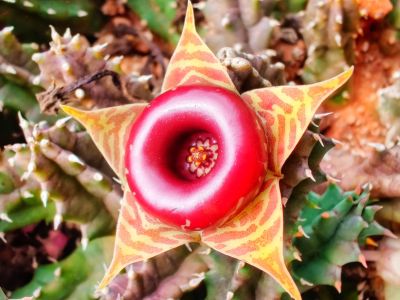Lifesaver Cactus Plants
Lifesaver plants can produce amazing 5-pointed, star-like blooms with zebra stripes and a thickened center that resembles a root beer-flavored Lifesaver. If this isn’t enough to intrigue you, they have fascinating 4-sided stems with soft teeth along the edges. In lower light situations, these are deeply green, but they attain a reddish tinge in full sun. These are not frost-hardy but you can try growing Huernia cactus on the patio in summer with some protection from the midday sun. Succulents, like cactus, are some of the easiest plants to care for and provide a range of texture and form for any gardener’s taste. Growing Huernia cactus as houseplants is preferred for most regions of the country, as they are not tolerant of cold weather.
How to Grow a Lifesaver Cactus
Choose a well-draining container, preferably one that is unglazed and will allow evaporation of excess moisture. Use a good cactus mix or make your own blend of 1 part potting soil and 4 parts gritty material. Lighting is of special concern with Huernia cactus care. They grow under plants in their native range and can exhibit stress if grown in searing heat and light. Try an eastern or western window that is bright most of the day but doesn’t experience the hottest rays of the day. A sensible watering schedule is the key to caring for Huernia. As with most succulents, the plant is prone to rot if it is too wet, but it does need supplemental water during its growing season. In winter, the plant hardly needs water at all, just once per month on average, as it is mostly dormant and not actively producing growth. In spring through summer, water the plant when the soil is dry to the touch. Make sure any saucer you have is emptied of water to prevent root rot. Another important part of Huernia cactus care is temperature. If you are growing the plant outside, it should be moved indoors if temperatures drop to 50 degrees Fahrenheit (10 C.). Pests are rarely a problem, but occasionally mealybugs can become a concern. Repot any purchased plants and spray with a 1:10 dilution of rubbing alcohol and water.
Additional Info on Caring for Huernia Cactus
You will rarely need to repot your Lifesaver plant. They prefer a slightly crowded environment and this will also keep a tight, compact plant. Change the soil every two years, but you can usually keep the same pot. Cactus plants, in general, benefit from supplemental feeding during their growing season. Gradually increase the amount of water you give the plant in April or May. At this time, feed the plant with a 15-15-15 liquid plant food once per month diluted by half. Stop fertilizing in late August to prevent new growth from forming while the plant goes into dormancy. Huernia zebrina doesn’t really need pruning unless you want a smaller plant. You can save the cuttings, let them callus for a few days, and then pot them up to create new plants. This is a really easy and fun little plant to grow and enjoy, season after season.
